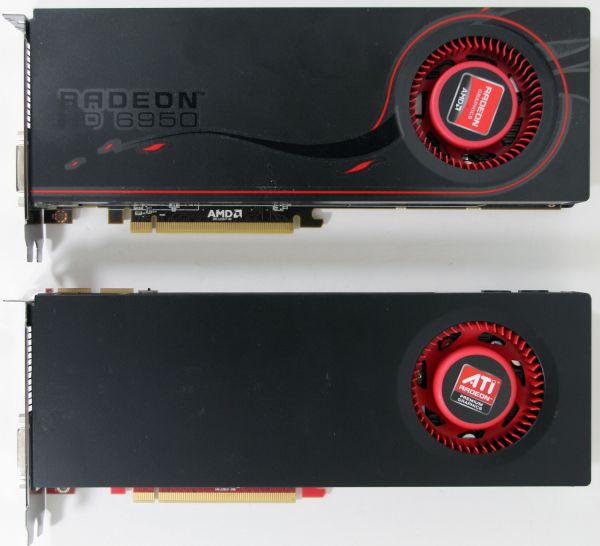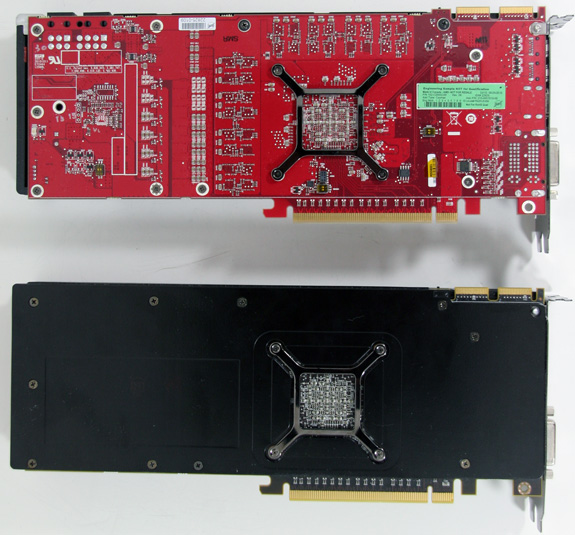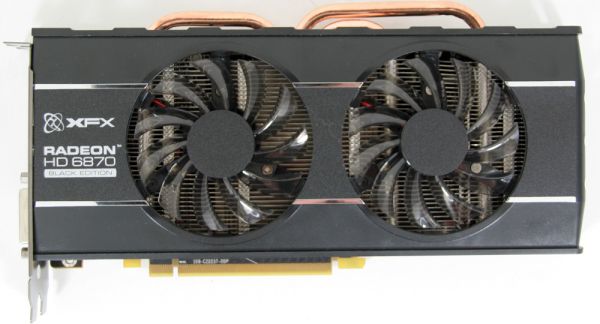AMD’s GTX 560 Ti Counter-Offensive: Radeon HD 6950 1GB & XFX’s Radeon HD 6870 Black Edition
by Ryan Smith on January 25, 2011 12:20 PM ESTMeet The Radeon HD 6950 1GB and XFX Radeon HD 6870 Black Edition
We’ll start our look at today’s cards with the headliner: AMD’s Radeon HD 6950 1GB. As we’ve previously established our 6950 is an engineering sample – perhaps an early one – so there’s not much to look at. Save for the kind of cosmetic defects you’d expect on an engineering sample, it’s for all practical purposes identical to the production 6950 2GB, and that’s intentional. AMD set out to make the 6950 1GB identical to the 6950 2GB other than the use of lower capacity GDDR5 chips, and this is what they have accomplished.

Top: 6950 2GB. Bottom: 6950 1GB Engineering Sample

Top: 6950 1GB Engineering Sample. Bottom: 6950 2GB
Since producing a 1GB card involves little more than replacing 2Gb memory chips with 1Gb memory chips, the true design innovations are going to come from AMD’s partners. Sapphire already has a 6950 1GB out with a custom cooler, and as AMD’s other partners get situated with 1GB cards we expect to see much of the same with them.
One item worth noting is that because our card is based on the reference design, it includes the BIOS switch at the top of the card. This means reference-based 1GB cards are going to have the same BIOS failsafe in them – however suitable BIOSes for the unlockers among you are another matter. Without some BIOS hacking (and possibly more), existing 6970 BIOSes are unsuitable as they’re meant for 2GB cards. Until such a time comes where a 6970 1GB BIOS can be developed, the 6950 1GB is not going to be a good card for unlocking. For the time being unlockers are going to want to stick to 2GB cards.
The Radeon HD 6950 1GB is launching with an MSRP of $259. At this time you can find reference-style 2GB cards for as little as $269, making the 1GB cards a rather simple $10 trade-off if you don’t mind mail-in rebates.
XFX Radeon HD 6870 Black Edition
Our second card of the day is XFX’s 2nd generation Radeon HD 6870 Black Edition (687A-ZDBC), the card that AMD originally proposed as the GTX 560 Ti’s competitor. Clocked at 940MHz core and 1150MHz (4.6Gbps data rate) memory, it runs at 40Mhz (4%) core and a 100MHz (9%) memory over the reference 6870. Overall this is a mild overclock, particularly as the 6870 is core-bound as opposed to memory-bound most of the time.
With such a mild overclock we had little reason to pay attention to the card, particularly once we completed our GTX 560 Ti benchmarking and saw that it was 10-20% faster than the stock-clocked 6870. Indeed it wasn’t until we tested the card that we saw something that grabbed our attention. Or perhaps I should say heard.
At the risk of spoiling the rest of our article, this card is for all practical purposes silent. At idle it’s only as loud as the noise floor of our GPU testbed, and at load – even under Furmark – it’s the same story. We measured 41.4dB at both idle and load, making it the quietest actively cooled mid-range card we have ever tested in our existing rig. Even the remarkably quiet GTX 460 can’t hold its ground to the 6870 Black Edition, it’s that quiet.
So what’s XFX’s secret? It’s much the same story as with the GTX 460. While the 6870 reference design uses a blower XFX is using an open-air cooler, specifically a double-fan cooler with 3 copper heatpipes that’s very similar to MSI’s Twin Frozor and Gigabyte’s Super Overclock cooler. Open-air coolers are already capable of being much quieter than blowers, and when done correctly a double-fan arrangement can be quieter than driving a single fan at higher speeds. Combining this highly effective cooler with the 6870’s Black Edition’s low TDP (~160W) results in a very quiet card that by all indications cannot be beaten at this point in time.
Rounding out the package, there are no real meaningful extras to discuss. Aside from some trinkets (stickers, case badges, etc), the only other piece of hardware in the box is a short CrossFire bridge. XFX has kept it simple: the only things that really matter are the card and XFX’s lifetime warranty.
The Radeon HD 6870 Black Edition doesn’t have a set MSRP, but it’s currently available for around $229 with a mail-in rebate, making it roughly $10 more expensive than a stock-clocked card. Or compared to XFX’s lineup, the non-Black Edition version of this card is a mere $4 less at $225; so you’re looking at a $4 factory overclock and $6 for a supurb custom cooler.












111 Comments
View All Comments
sinPiEqualsZero - Tuesday, January 25, 2011 - link
The market speaks louder than needlessly outraged readers. Like it not, overclocked cards will continue to be produced. In order to be responsible journalists, they have to include them in order to evaluate their value to the consumer.He also made clear that AMD was bumping up the launch at little notice. I think you are making much ado about nothing and will see plenty of factory-OC'd cards in the near future.
prdola0 - Tuesday, January 25, 2011 - link
It's not about not liking benchmarks of overclocked cards. As I stated, I didn't agree with the whining about GTX460 OC as well. I think it's legitimate to include OCed models. But if you do it, then do it for both sides. Especially after such a drama and a strict decision by the writer not to do it. That is the point.britjh22 - Tuesday, January 25, 2011 - link
In the original 68xx review, the site got flack for including a highly overclocked GTX 460, at NVIDIA's asking.This time, they review the GTX 560 Ti against stock clocked rivals. In a separate article they present ATI's competitive reaction to the GTX 560 launch. I think Anandtech and Ryan handled this correctly. They analyze and present the GTX 560 as a reflection of what NVIDIA has done, and produce a separate article where they focus on the GPU ecosystem as a whole.
In this way I think it looks a lot less like they kowtowed to a vendor's requests, and in fact show how targeted and thought out AMD/ATI's launch is. In a market this closely matched for performance and price, and with vendors offering customized versions of AMD/NVIDIA products, it's hugely complicated.
Well done Anandtech for today's articles, they definitely made my lunch hour more enjoyable.
prdola0 - Tuesday, January 25, 2011 - link
"They analyze and present the GTX 560 as a reflection of what NVIDIA has done, and produce a separate article where they focus on the GPU ecosystem as a whole."Well if they did that, why didn't they include the OCed GTX560 Ti as well? Consider the fact that there are likely going to be a lot of oveclocked GTX560s as with the GTX460 card. That isn't part of the GPU ecosystem?
britjh22 - Tuesday, January 25, 2011 - link
The card just launched, it's very possible they don't have one, or didn't have the time to put that through the test suite with all the other things coming off NDA today. As a news source it's more sound for them to be able to have timely coverage, even if they have to revisit something they didn't have time for in the original article.It sounds like most tech blogs were up very late compiling, testing, and writing for these launch articles. Most people are content with waiting a week for the entire picture to become clear, and if not, well that is the price for early adoptership.
80/20 rule.
prdola0 - Tuesday, January 25, 2011 - link
You may be right that they didn't have any OCed GTX560s. However while there are many more review sites that did receive them, I kinda doubt that a site with such a big name as AnandTech wouldn't receive any.Ryan Smith - Tuesday, January 25, 2011 - link
We do in fact have one: an MSI Twin Frozr II (880MHz core). You'll see it later this week, as we didn't have time to pull it in to our review on top of everything else that was going on today.SlyNine - Wednesday, January 26, 2011 - link
Just tell him to quite his whinning .. jk But for the love of god it's not a big deal. I'm just glad we get the objective tests that we do, As opposed to taking a shot in the dark when buying cards.softdrinkviking - Wednesday, January 26, 2011 - link
agree 100%this was totally about an AMD market reaction, and both cards reviewed are varients of other cards previously released by AMD.
absolutely no foul.
3DVagabond - Sunday, January 30, 2011 - link
Completely different scenario. This is a review of 2 AMD cards. This is not the review of the GTX-560 with the inclusion of a highly overclocked card that was put in at AMD's request/insistence, as was the case with the GTX460 FTW. Add to that there was also input from nVidia what cards of theirs to NOT include for comparison in the 6870 review and even benchmarks they wanted AMD cards tested with (HAWX2). Again, not even close to the same scenario.